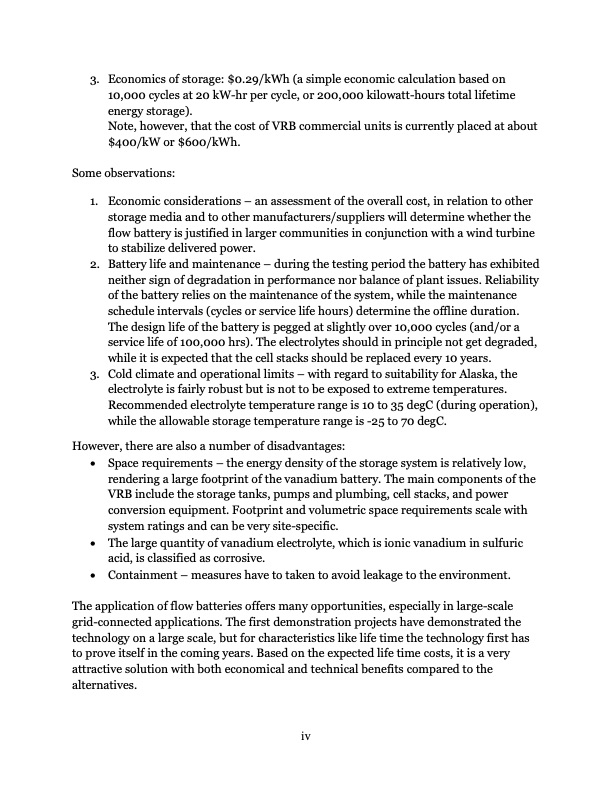
PDF Publication Title:
Text from PDF Page: 009
3. Economics of storage: $0.29/kWh (a simple economic calculation based on 10,000 cycles at 20 kW-hr per cycle, or 200,000 kilowatt-hours total lifetime energy storage). Note, however, that the cost of VRB commercial units is currently placed at about $400/kW or $600/kWh. Some observations: 1. Economic considerations – an assessment of the overall cost, in relation to other storage media and to other manufacturers/suppliers will determine whether the flow battery is justified in larger communities in conjunction with a wind turbine to stabilize delivered power. 2. Battery life and maintenance – during the testing period the battery has exhibited neither sign of degradation in performance nor balance of plant issues. Reliability of the battery relies on the maintenance of the system, while the maintenance schedule intervals (cycles or service life hours) determine the offline duration. The design life of the battery is pegged at slightly over 10,000 cycles (and/or a service life of 100,000 hrs). The electrolytes should in principle not get degraded, while it is expected that the cell stacks should be replaced every 10 years. 3. Cold climate and operational limits – with regard to suitability for Alaska, the electrolyte is fairly robust but is not to be exposed to extreme temperatures. Recommended electrolyte temperature range is 10 to 35 degC (during operation), while the allowable storage temperature range is -25 to 70 degC. However, there are also a number of disadvantages: • Space requirements – the energy density of the storage system is relatively low, rendering a large footprint of the vanadium battery. The main components of the VRB include the storage tanks, pumps and plumbing, cell stacks, and power conversion equipment. Footprint and volumetric space requirements scale with system ratings and can be very site-specific. • The large quantity of vanadium electrolyte, which is ionic vanadium in sulfuric acid, is classified as corrosive. • Containment – measures have to taken to avoid leakage to the environment. The application of flow batteries offers many opportunities, especially in large-scale grid-connected applications. The first demonstration projects have demonstrated the technology on a large scale, but for characteristics like life time the technology first has to prove itself in the coming years. Based on the expected life time costs, it is a very attractive solution with both economical and technical benefits compared to the alternatives. ivPDF Image | Advanced Battery Storage Systems Testing at ACEP VRB ESS

PDF Search Title:
Advanced Battery Storage Systems Testing at ACEP VRB ESSOriginal File Name Searched:
ACEP-VRB-Testing-Report.pdfDIY PDF Search: Google It | Yahoo | Bing
Salgenx Redox Flow Battery Technology: Salt water flow battery technology with low cost and great energy density that can be used for power storage and thermal storage. Let us de-risk your production using our license. Our aqueous flow battery is less cost than Tesla Megapack and available faster. Redox flow battery. No membrane needed like with Vanadium, or Bromine. Salgenx flow battery
| CONTACT TEL: 608-238-6001 Email: greg@salgenx.com | RSS | AMP |